The answer to the question of how spaced repetition was created should be started with a reference to antiquity. Thinking about memory was conducted by Greek philosophers. Plato (427-347 BCE) devoted a work to it, as did his student and critic Aristotle (388-322 BCE). The latter of these collected his considerations, among others, in the treatise “On memory and recollection”. The Latin phrase repetitio mater studiorum est (repetition is the mother of learning) demonstrates that even the ancient Romans were aware that repetition influenced memory, although they obviously weren’t able to express this numerically.
The first research into memory
Probably the first scientist to research and describe the processes related to forgetting in a truly scientific manner was the German psychologist Hermann Ebbinghaus. While he didn’t invent the term spaced repetition, in the years 1879-80 and 1883-1884 he carried out two series of experiments of over a year’s duration which he himself designed, and whose results he published in the monograph Über das Gedächtnis, or Memory: A Contribution to Experimental Psychology in English. Ebbinghaus based his tests on the idea of memorising series of invented syllables consisting of two consonants separated by a vowel, such as KAB, LEZ, GEC, and so on. The absence of meaning was to guarantee the freshness of the information to be memorised and to minimise the risk of repetitions of them happening by themselves. As he wrote in his work, the material he memorised generated no associations or emotions and enabled him to create series of any length while not providing an easy way of applying mnemonics.
Importantly, Ebbinghaus didn’t investigate whether a given series was forgotten or not, assuming in advance that he would not be able to recreate it in its entirety. What he did do was measure the reduction in time, or amount of repetitions which he required to relearn them after a period. As part of each test, he memorised a few series, each one consisting of a dozen or dozens of syllables, reading and repeating them until he was able to repeat them perfectly from memory. While doing this, he measured the number of times he had to read and recite them until he memorised the series, as well as the mean time devoted to reading or reciting a given syllable. Then, he compared the time needed to memorise a completely new series with the time needed for its relearning, in that way calculating the “learning saving”, which in his opinion was directly related to the degree of memorisation, and so the retention of a given series.
As part of his research, Ebbinghaus conducted several series of experiments in which he researched:
- the number of repetitions necessary to repeat a series of syllables of a certain length from memory (Chapter 5),
- the influence of the number of repetitions performed on first memorisation (from insufficient to too many) on the learning saving after 24 hours (Chapter 6)
- the time spent on relearning a series of syllables (first relearning) after successive intervals: 20 minutes, 1 hour, 9 hours and after 1, 2, 6 and 31 days (Chapter 7)
- the number of repetitions of a series required to relearn series of varying lengths on 6 successive days (a series of 6 sessions of relearning) at 24-hour intervals (Chapter 8)
- the influence of changing the order of syllables in a series on the saving when relearning (Chapter 9).
Today, the most often cited effect of Ebbinghaus’s research concerns his experiments described in Chapter 7, where the psychologist proposed a formula expressing the savings in relearning relative to the time passed from first learning a series of syllables. These savings were as high as 58% for the shortest interval of 20 minutes, to 34% for one day, to 21% for 31 days. Ebbinghaus considers that these savings are a measure of the size of memory at the end of each interval. Based on the results of his experiments, Ebbinghaus constructed the mathematical formula which describes the saving on first relearning b, which he interprets as retention, using a function based on the logarithm of time t, which has passed since the first effective memorisation:
b = 100k/((log t)c +k),
where k and c are the appropriately chosen constants to maximise concordance with the measures used in the experiment. Ebbinghaus did not include any graphs in his work, but his forgetting curve can be created from the tables of data in his work.
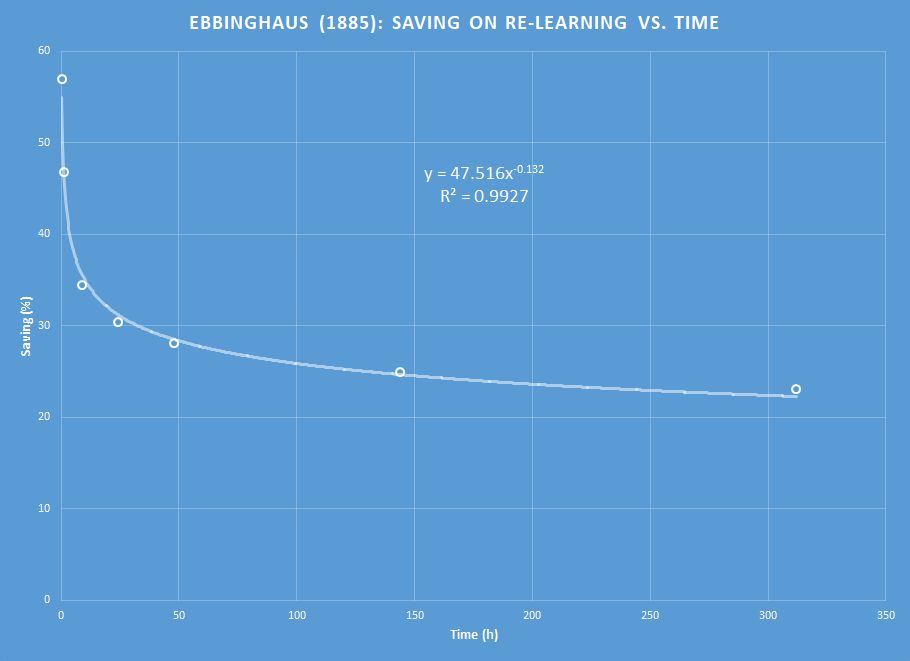
Ebbinghaus’s curve. Source:SuperMemo.guru
Research into the influence of repetition on learning in the 20th century
For over 100 years, Ebbinghaus’s research made no impact on mainstream psychology or teaching methodology. The subject of memory retention and repetition was taken up only by a few scientists and practitioners who are nevertheless worth mentioning. In 1932, Prof. C. A. Mace, a British philosopher and psychologist, proposed a plan for repetitions based on intervals of 1, 2, 4, 8 days, and so on. In 1939, H. F. Spitzer published the results of a mass experiment where he applied different testing cycles on different groups of learners. In the 1960s and ‘70s, among others, H. Simon and R. Bjork published their works on memory and optimised repetition cycles. Also in this period (1967) P. Pimsleur, an American linguist and writer of language courses, published his short article A memory schedule, in which, perhaps for the first time, appeared the characteristic sawtooth wave for the likelihood of remembering. Pimsleur, drawing on his own experience, as well as several other publications, puts forward the hypothesis that the “ideal” learning cycle involves repetitions at exponentially growing intervals, so, for example, 5 seconds, 52 = 25 seconds, 53 = 125 seconds etc. In 1972, Sebastian Leitner, a German journalist and popular scientist, published the first practical idea for a system of organised repetitions of information written on flash cards. The idea involves moving flash cards from one box to another. The cards in the first box are repeated daily, and less frequently for each successive box. Flash cards successfully repeated are moved to the next box, while those not remembered are returned to the previous, or first box, depending on the system.
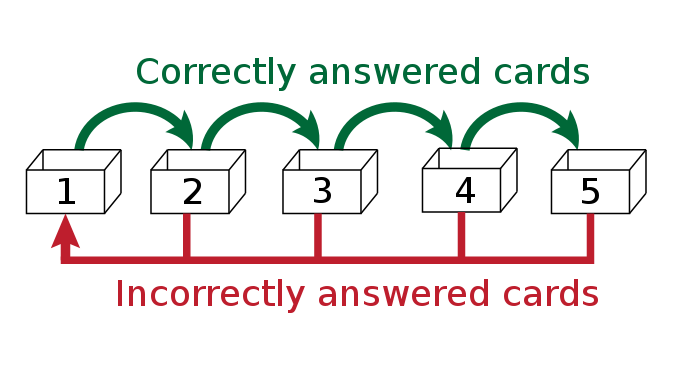
Leitner system. Source: Wikipedia
A defect in the series hitherto presented is their rigidity, and so their inability to adapt rapidly to the nature of the information to be remembered. Both Ebbinghaus and Pimsleur themselves note that their results are typical for the given type or difficulty of material to be memorised. Ebbinghaus’s formula concerned the fe adres of memorising during the first relearning of a series of 13 meaningless syllables. In Chapter 8 he writes that a similar result could be achieved only for a series of similar length. Pimsleur, who concentrated on memorising vocabulary, notes that it would be stupid to expect that the same sequences of repetitions could be repeated for all words. As he explains, shorter, frequently occurring, related words (e.g. Fr. le garage is similar to garage in Eng. or garaż in Pl.) may require a small number of repetitions, while longer, more rarely encountered, unrelated words (e.g. Fr. ahurissement, stupefaction in Eng. or oszołomienie in Pl.) — might take many. In addition, as we already know, a word which from the point of view of an individual’s native language might be easy to learn or related may not be the same for a speaker of another language. So, regardless of how precisely the observations or intuitions were recorded here, they concerned specific examples of data which cannot be optimally applied to others. To overcome this limitation it was necessary to apply computer analysis to a large array of varied learning data over a longer period of time. In the 1980s, Piotr Woźniak (who invented spaced repetition and created the SuperMemo method), seeking a method to enable him to effectively learn large amounts of material, came to the conclusion that if he could discover the correct memorisation pattern, he could use a computer to create the optimal model for him and other users to individually learn any information.
When was spaced repetition invented?
In 1982, Woźniak, at that time a student of molecular biology, was frustrated by the amount of material he was required to learn on his studies, and how little of it he was able to remember a few months after an exam. He began to note down and actively look through the information necessary for him to learn biochemistry and English. This amounted to thousands of paired questions and answers. He wrote them down on pieces of paper which he glanced at from time to time, whenever he had a moment, each time noting the date of the revision, noting the information he had forgotten and its quantity. Using this material he discovered and applied the first rules of formulating knowledge. Among others, these included the principle of testing your knowledge through active recall, rather than passively reading, and the minimum information principle, whereby a single question focuses on a single piece of information to be learnt. With time, he realised that successive repetitions strengthened the memory of particular items of information, and that each had its own life cycle. On the basis of an analysis of the loose data from these repetitions, Woźniak drew his first forgetting curve.
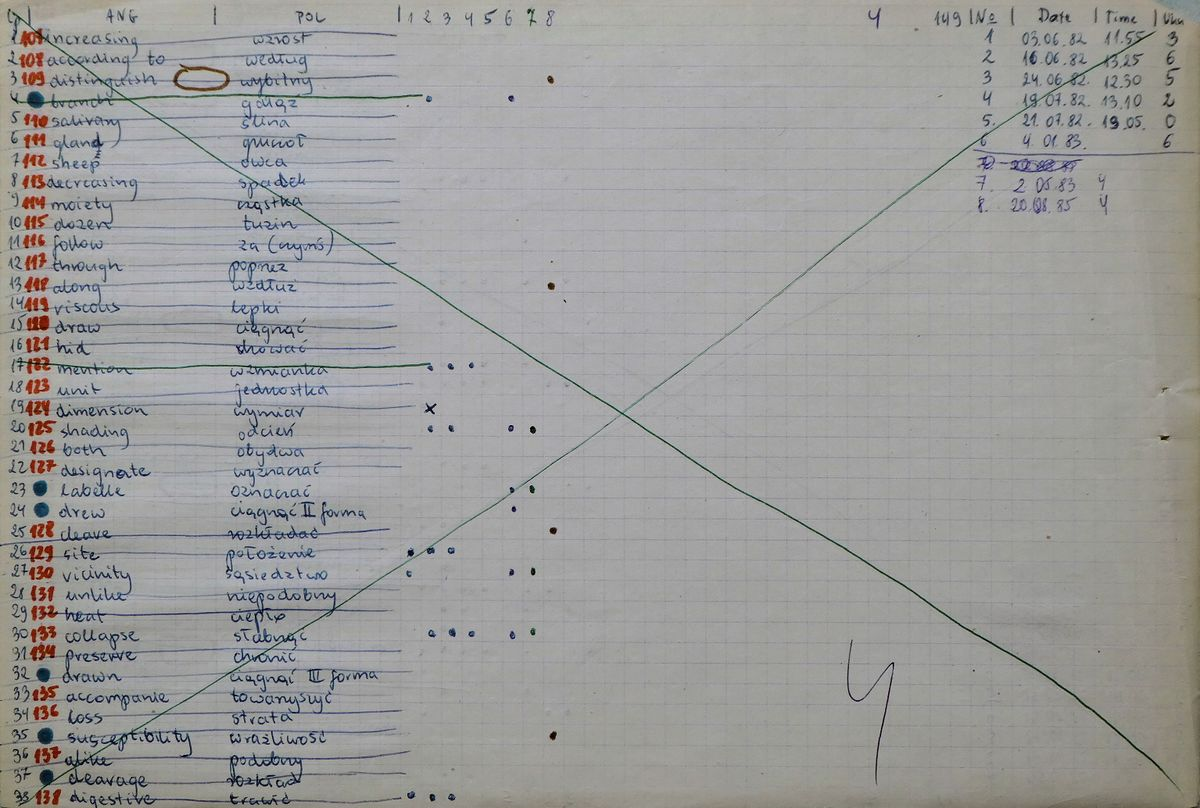
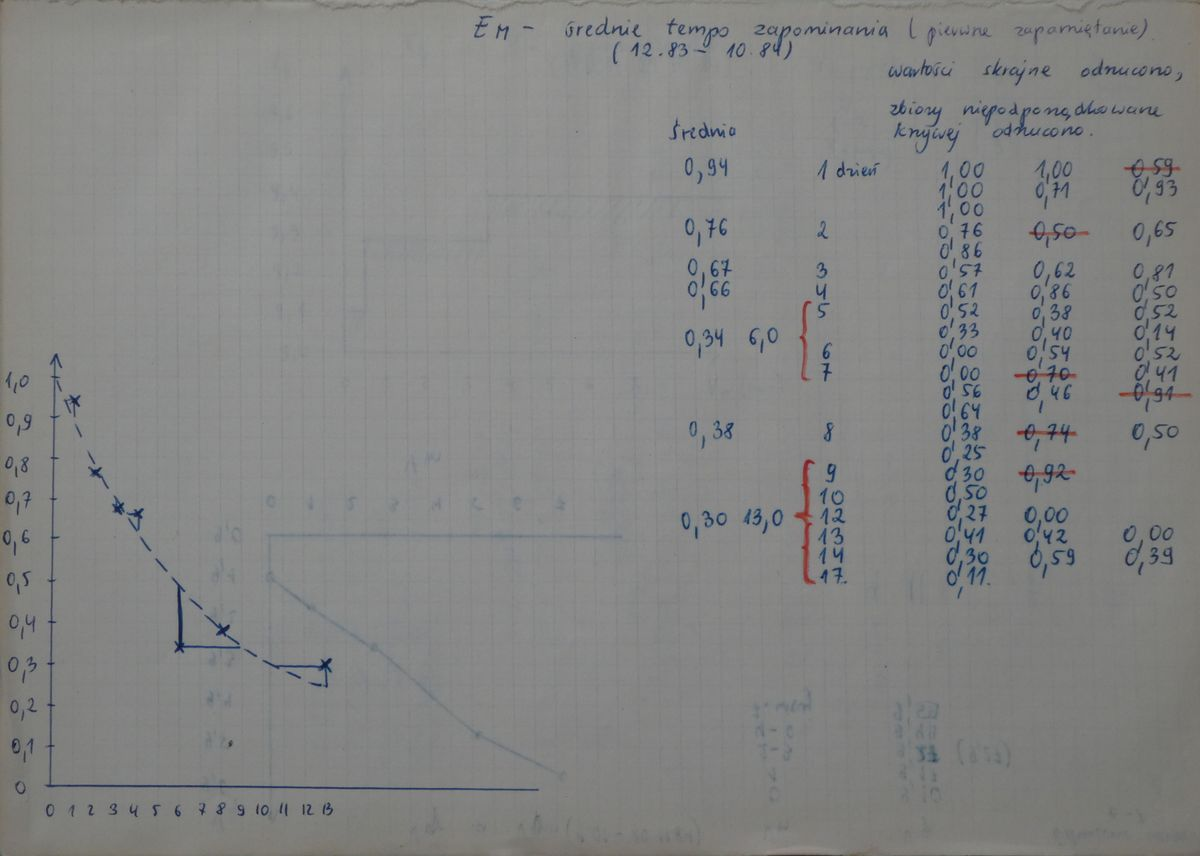
Notes from Woźniak’s experiments, 1982-1984
In 1985, Woźniak, who didn’t yet possess a computer, carried out a series of experiments with remembering sets of English vocabulary, where he measured the number of errors during successive repetitions, using different intervals. He tested the longest interval for an acceptable level of errors, and then, assuming this interval to be a constant element of the cycle, he measured the next one, and so on. This led him to the creation of a cycle of increasing intervals between repetitions (1, 7, 16, 35 days, then x2), which he used to learn his set of questions on human biology, and also to formulate the SuperMemo method on paper. Today, it might sound somewhat startling, but at that time Woźniak had no knowledge of the works by Ebbinghaus, Spitzer or Bjork. The Internet didn’t yet exist, and getting to such publications required laboriously trawling through library resources. Woźniak was, though, above all focussed on his own studying and on drawing conclusions to make it more effective. He was convinced that someone else must have already measured the best intervals more precisely than him, but thought that his own experiments would be faster and more interesting than looking through a lot of scientific literature. As he himself admits, it was only in 1986-87 that he spent a lot of time in the university library looking for thorough research on optimising repetitions. Yet, he found nothing that could add to his own experiments.
In autumn 1985, Woźniak began studying IT, and a few months later bought his own, first personal computer, a ZX Spectrum. In the ZX, the data needed to be copied into the computer’s memory each time from a magnetic tape, which limited the possibilities, but that didn’t stop him from carrying out numerous simulations and analyses. At this time, Woźniak came to the conclusion, among others, that the increase in knowledge using his method was almost linear, that it didn’t tail off with the amount of material memorised, and the fastest tempo for acquiring new information could be achieved by allowing for a level of forgotten material of about 20-30%.
In 1987, thanks to his family, Woźniak was able to buy his first PC with a hard disk, thanks to which three months later, on December 13, 1987, the first version of the SuperMemo program (application) was born. Woźniak used it to learn about 10,000 pieces of information in the first year, in this way beginning the construction of an enormous database which he could use for his further research. The first application used a modified version of the SuperMemo algorithm (called SM-2), which assigned a dynamically calculated difficulty coefficient to each piece of information, affecting the length of intervals on an individual basis. Forgotten information returned to the start of the cycle, however it retained its hitherto coefficient of difficulty. In 1998, the SM-2 algorithm was made publicly available on the pages of supermemo.com, which to this day remains the inspiration for many other applications using spaced repetitions. For many years it has been used, among others, by Anki, for a certain time it was used by Quizlet.
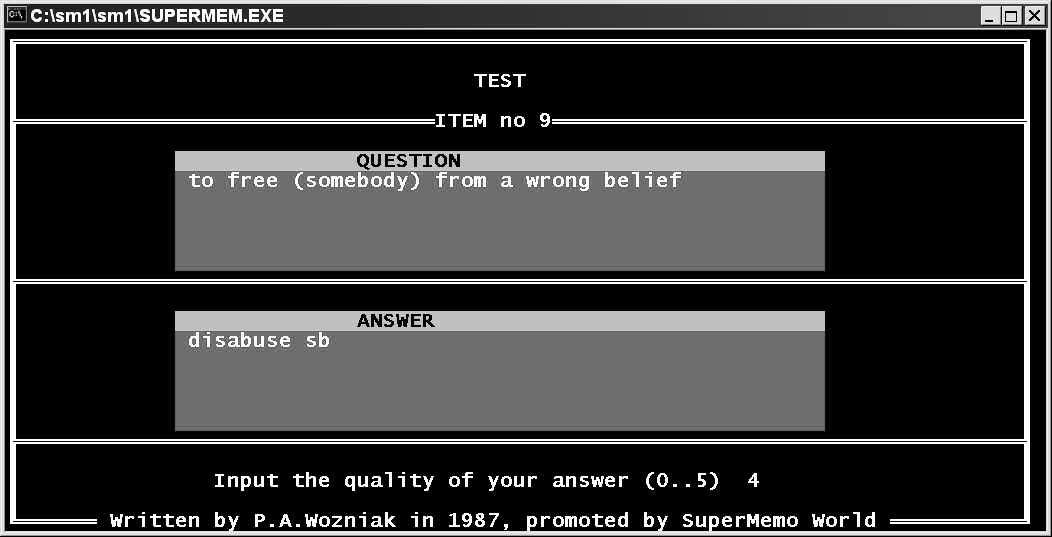
The first SuperMemo application
Woźniak, though, created further versions of the algorithm, improving its accuracy and adaptability to the characteristics of the individual user and the material to be memorised. Unlike SM-2, the following versions were based on, among other things, a measure of the actual knowledge retention of the user, which constituted feedback, altering how the algorithm operates. This made it possible to control repetitions in order to achieve the desired level of retention. The standard level is 90%, but because the algorithm is able to predict the likelihood of the user remembering information at any given moment, the level can be set to 80% or 95%, say, which reduces or increases the frequency of the repetitions. At the same time, Woźniak published the theoretical basis of his work in the form of a master’s and doctoral thesis, as articles and as ongoing publications on the pages of SuperMemo.com. Today, the entirety of his publications can be found on the webpage SuperMemo Guru. To date, the culmination of this research is the algorithm SM-17, created in 2016, based entirely on the theory of two components of memory.
So, inasmuch as we can state, based on what we now know, that Plato can be regarded as the father of the philosophical considerations of memory, Ebbinghaus as a pioneer of the mathematical approach to research on forgetting, it is Piotr Woźniak who should be regarded as the creator of spaced repetition, and so a method of establishing the optimal moment for revision to achieve a desired level of retention. Thanks to the use of computers, his method can, within the SuperMemo application, be individualised to meet the needs of a specific user.
You can find more about the history of SuperMemo and spaced repetition in the article “True history of spaced repetition” by Piotr Woźniak.



